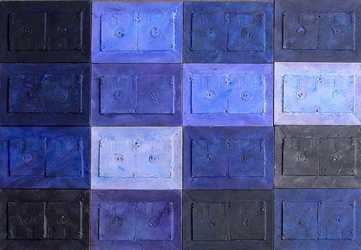
October Exhibition 2004 Masayoshi Ito October 5th, - October 30th, 2004 Gallery Hour |
 |
|---|
Gallery NYCoofs 6th exhibition is Masayoshi Itohfs one-person show. 50 works, with two side-by-side floppy disks directly attached to a small wooden stretcher heavily painted with acrylic-based modeling paste and paint, cover the walls. One can observe how the works were made with what remains of the nails used to fasten the floppy disks underneath the grayish colored textured surface. The issue that arises from these works is not whether or not the surface image can be substantiated as painting, but whether the works in and of themselves exist as an object. Then, the main objective becomes the environmental space installation filling the gallery wall created by the 50 or so works. Other works in the show are a standing figure series made of twisted wire placed within the back-side of a small canvas on a wooden stretcher. This figure is the metallic color of the material itself floating out of a black-painted background and at times with a moon-like shape hovering over its head. A freelance illustrator, Itoh strived to spend his lifetime painting since his youth. Including those years, he has continued to paint for over 40 years. He has done a great many works which took him to a variety of stylistic directions. What might form the core of the works can be sensed in his own words, gPainting must be done to satisfy oneself.h The themes of his works through the years include experiential landscapes from his youth, a fishing port, himself playing the saxophone, the pattern of womanfs kimono that became affixed to his mind at some point in his life. These works were recognized in his 1999 one-person show at the Nerima Art Museum, and the encouragement award at the 2000 art contest at the Shoto Art Museum in Tokyo. Although the works in this New York show are said to be recent, the discrepancy compared with the works from the past is perplexing. How did this sudden mutation occur? Of course, the artist always has the freedom to change his work. Changing onefs own work is a way to pursue experiences one has yet to have. As a matter of fact, that is how an artistfs life can be realized. And, in making that change the rationale should provide the context. Past themes had to do with returning to onefs birthplace, in actuality, romanticism of returning to where onefs heart lies and the colors are reminiscent of a colored filter that invite nostalgic viewing of landscape. In contrast, the removal of emotion is indicated in the gray tone expressing the anti-painting attitude in the recent works. A commonality between the two is not to be found. An occurrence of sudden break off is all that one might presume. These new works decisively attempt to progress by denying the past. There is no need to question the past; this is it now. But no matter the beak off, what is not only on the surface begins to reveal itself in the context with the distance of time between the break offs. There may be a need for reconsideration by placing the work in front of oneself for a careful reflection. Itohfs works exhibit his enthusiasm as a consequence to his break off. One wonders with interest what may be in store the next time.
|
||
Gallery writer: Hitoshi Nakazato |
||
